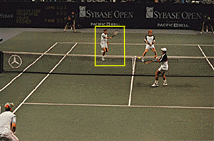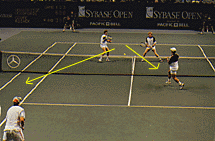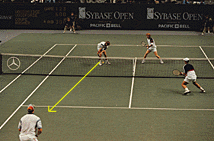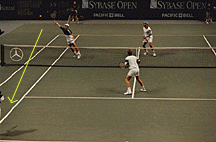If you are a doubles player, you know that a big part of the game is having the ability
to execute good volleys. You need pretty good hands to do well. But that's not all. Let me
ask you a question regarding volleying, not on the technical side but rather on the
tactics. When you approach the net in doubles where do you place your volleys? If your
answer is, "Where the other guy isn't," then you need to read this lesson
carefully.
The basic strategy about placing volleys in doubles is; when you have to hit a low
volley (below the net), stay away from the closest opposite net player and push the ball
back deep. When you get a high volley (contact is made above the net) where you are in a
balanced position to execute, hit it towards the closer player and move foreword (or if
you have time angle it away).
The only exception to this rule is when you get a low volley and the opposite net man
starts crossing or faking, then it is important to go behind him every so often to keep
him honest.
In this lesson, let's take a look at the best in the business, Mark Woodforde and Todd
Woodbridge ("The Woodies" ) and analyze their volley strategy. The Woodies are
on the far side of the net.


Look at the first two frames, you will notice that Todd Woodbridge (deuce) is moving
forward to volley a high ball hit by the closest opposing player. Since Woodbridge is
balanced and the approaching ball is above the net, he has two choices. Try to tag the
opposite net man, or to be kind, and angle the volley sharply to his right.
 In this frame, notice Woodbridge (far deuce
side) again is making the volley. But look at how low he is forced to make this shot. In
this situation, Woodbridge won't debate his shot selection. He'll instinctively push the
volley back to the deep man to buy his team more time to establish a better position at
the net.
In this frame, notice Woodbridge (far deuce
side) again is making the volley. But look at how low he is forced to make this shot. In
this situation, Woodbridge won't debate his shot selection. He'll instinctively push the
volley back to the deep man to buy his team more time to establish a better position at
the net.
 In this frame the Woodies are in the bottom half
of the photo. The player on the far deuce side is about to execute the volley.
In this frame the Woodies are in the bottom half
of the photo. The player on the far deuce side is about to execute the volley.
Take a look at two things, the height of the ball and his footwork. The ball is high so
he might want to go towards Woodbridge (in the near deuce court), but on closer inspection
you can see that he is off-balanced and stretched out, which means it's unlikely that he
can hit a clean, forceful volley. Volleying to the opposite net man (Woodbridge) would be
very dangerous. Nine out of ten times, the player executing such a difficult, high volley,
will be off-balanced and still be in the process of recovery when the opponent hits it
past him. From a tactical perspective, his best option is to push this volley back deep
and buy time for better positioning and better balance.
Remember, think like "The Woodies" and be tactically smart when volleying: low
volley, push it back to the deep man; high volley, tag the closest person or angle it
away. Again, the only exception to the low volley rule is if the opposite net man is
crossing or faking (then go behind him every so often to keep him guessing). The only
exception on the high volley rule is when you're off-balanced or stretched out (then
vollely back to the deep man to buy time and get a better position). Good luck and always
be conscious on what type of volley your about to make, low or high.
Send email to the author
We encourage you to email your comments (pro, con, appreciative, whatever) directly to
the author. To send email to Monty Basnyat, click
here.
Go To: Lessons Library